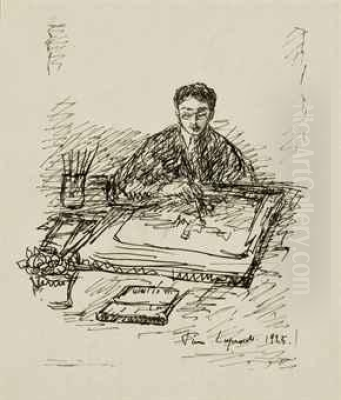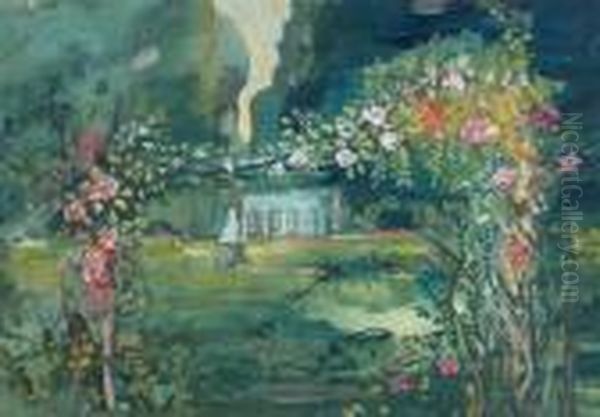
Pierre Laprade (1875-1932) stands as a distinctive figure in the landscape of early 20th-century French art. Primarily celebrated for his evocative landscapes, intimate still lifes, and delicate figure studies, Laprade navigated the currents of modernism with a unique sensibility. His work, often characterized by a gentle melancholy and a harmonious vision of the world, forms a bridge between the lingering influences of Romanticism and the innovations of Impressionism and Post-Impressionism. Though perhaps less revolutionary than some of his contemporaries, Laprade cultivated a personal style marked by refinement, sensitivity, and a quiet emotional depth.
Born in Narbonne, France, Laprade's artistic journey led him to Paris, the vibrant heart of the art world at the turn of the century. There, he immersed himself in the study of painting, absorbing the lessons of the past while engaging with the burgeoning modern movements. His formative years saw him align with circles that appreciated both tradition and innovation. An early and significant connection was established with the Galerie Druet, a prominent venue known for championing contemporary artists, which provided Laprade with crucial exposure in the early decades of the 20th century.
Artistic Style and Influences
Laprade's artistic signature lies in its subtle fusion of influences. His canvases often depict a world imbued with harmony and beauty, yet frequently touched by an underlying sense of wistfulness or melancholy. This emotional duality has led to comparisons with the Rococo master Jean-Antoine Watteau, whose depictions of fêtes galantes similarly blend elegance with a poignant transience. Laprade, like Watteau, seemed drawn to moments of quiet contemplation and the ephemeral beauty of nature and human interaction.
The impact of Impressionism is evident in Laprade's attention to light and atmosphere, though his approach diverged from the purely optical concerns of artists like Claude Monet or Pierre-Auguste Renoir. Laprade was less interested in capturing a fleeting moment of perception than in evoking a sustained mood. His palette, often favouring soft, silvery tones and a delicate transparency, particularly in his watercolours, contributed to the lyrical quality of his work. He masterfully captured the feeling of air and light, not just their visual appearance.

Post-Impressionist currents also shaped his vision. Echoes of Paul Cézanne's structural concerns might be discerned in the composition of some landscapes, while the decorative sensibilities and intimate subject matter explored by Nabis painters like Pierre Bonnard and Édouard Vuillard find resonance in Laprade's interiors and garden scenes. The influence of Émile Bernard, known for his work alongside Paul Gauguin involving simplified forms and bold outlines, can also be traced in certain aspects of Laprade's handling of form, particularly in his still lifes and figure paintings.
Key Works and Themes
Laprade's oeuvre encompasses a range of subjects, consistently treated with his characteristic sensitivity. Landscapes, often depicting serene gardens, parks, or gentle views of the French or Italian countryside gleaned from his travels, form a significant part of his output. Works like Vue d'un village dans la vallée, executed in watercolour and ink, showcase his ability to capture the essence of a place with fluid lines and delicate washes of colour. His watercolour Le petit Trianon points to an interest in historical settings, rendered with atmospheric grace.
Still life provided another important avenue for his explorations of form, colour, and mood. His 1919 painting Grape Seeds (Pépins de Raisin) is noted for its soft, silvery tonality and transparent quality, effectively capturing a sense of circulating air and what has been described as a "familial melancholy." This work reflects memories of his travels and his ability to imbue simple objects with emotional resonance.
Figure studies and scenes of quiet domesticity or leisure also feature prominently. The Walk (La Promenade), depicting a couple strolling in a setting reminiscent of Versailles, connects stylistically and thematically to the tradition of the fête galante, recalling artists like Jean Guérin as well as Watteau. It demonstrates Laprade's interest in courtly themes, reinterpreted through his modern lens, blending elegance with a gentle, almost dreamlike atmosphere.
The Salon d'Automne and Early Surrealist Echoes
A pivotal moment in Laprade's career occurred around 1913. He served as a jury member for the prestigious Salon d'Automne, a key venue for avant-garde art. In that year's exhibition, as well as at the Salon des Indépendants, Laprade presented works that marked a fascinating, albeit perhaps temporary, departure towards a more enigmatic and dreamlike style. Three paintings in particular stood out: Enigma of the Oracle (L'Énigme de l'Oracle), Enigma of an Afternoon (L'Énigme d'un après-midi), and a Self-Portrait.
These works, characterized by their mysterious atmosphere and suggestive imagery, captured the attention of influential figures in the Parisian art scene, including the young Pablo Picasso and the poet and art critic Guillaume Apollinaire. Apollinaire, a key supporter of Cubism and other modern movements, was intrigued by the psychological depth and unsettling quality of these paintings.
Intriguingly, these specific works by Laprade have been retrospectively viewed as significant precursors to Surrealism. Their exploration of the subconscious, the dreamlike, and the uncanny predates the formal establishment of the Surrealist movement led by André Breton a decade later. They seemed to tap into the burgeoning interest in psychology and the irrational that would fuel artists like Max Ernst and Salvador Dalí.
Further reinforcing this connection is Laprade's interaction with the Italian painter Giorgio de Chirico. When de Chirico was in Paris around this time, developing his own "Metaphysical Painting" style which profoundly influenced the Surrealists, he visited Laprade's studio. Discussions reportedly touched upon the relationship between dreams and reality, suggesting a shared interest in exploring realms beyond surface appearances. Laprade's brief foray into this enigmatic style thus places him at an interesting crossroads in the development of modern art.
Connections and Collaborations
Throughout his career, Laprade moved within the artistic circles of Paris, fostering connections with various painters and writers. His work's exhibition at major Salons naturally brought him into contact with the leading artists of the day. The attention from Picasso and Apollinaire underscores his relevance within the avant-garde milieu, even if his own path remained distinct.
His association with Giorgio de Chirico highlights a shared intellectual curiosity about the nature of reality and representation. Friendships with fellow artists, such as Albert Marquet, known for his subtle depictions of Parisian scenes and ports, likely provided mutual support and artistic exchange.
The provided sources also mention collaborations or associations with other artists. A stylistic link is noted with Jean Guérin, particularly in themes related to elegant leisure. Collaboration on certain art activities with the critic and historian Pierre Courthion is mentioned, suggesting Laprade's engagement with the broader art discourse. Furthermore, evidence points to joint work with Charles Guérin, another painter active during the same period, known for his intimate portraits and genre scenes.
Laprade also extended his artistic talents to the realm of illustration, creating works inspired by or accompanying the writings of poets such as Paul Verlaine and Marcel Prévost. This engagement with literature further highlights the poetic sensibility that permeated his visual art.
Challenges and Recognition
Despite his consistent production and exhibition activity, Pierre Laprade did not achieve the same level of widespread fame during his lifetime as some of his more radical contemporaries, like the Fauvist leaders Henri Matisse or André Derain, alongside whom he sometimes exhibited. His style, characterized by subtlety and nuance rather than bold provocation, may have been less immediately arresting to a public increasingly accustomed to artistic revolutions.
His association with the Galerie Druet was significant, but the eventual closure of galleries or shifts in the art market could impact an artist's visibility and sales. Evidence suggests some of his works were exhibited and sold in private galleries, such as one in Clermont-Ferrand, potentially at prices below what might be expected in the main Parisian market, hinting at the challenges of establishing a consistently high market value.
However, the lack of widespread popular acclaim does not equate to a lack of artistic merit. Critics and connoisseurs, particularly in later years, came to appreciate the specific qualities of Laprade's art. His work has been praised for its high degree of refinement, its purity of expression, and its consistent aesthetic vision. The perceived "melancholy" in his work speaks to a depth of feeling that resonates with viewers attuned to its quiet poetry. His mastery of watercolour, in particular, is often singled out for praise.
It is crucial to distinguish Pierre Laprade the painter from his near-contemporary, the prominent French architect Albert Laprade (1883-1978). Any discussion of challenges related to architectural projects, colonial urban planning (like in Morocco), or large-scale civic design pertains to Albert Laprade, not the painter Pierre Laprade, whose challenges were primarily those faced by many fine artists: navigating the art market, achieving critical recognition, and maintaining a unique voice amidst shifting artistic trends.
Legacy and Historical Influence
Pierre Laprade's legacy resides in his creation of a body of work characterized by its intimate charm, delicate beauty, and subtle emotional depth. He represents a strand of French modernism that valued sensitivity, harmony, and a connection to tradition, even while embracing modern techniques of light and colour. His paintings offer a respite, a world viewed through a lens of gentle contemplation.
His most distinct historical influence, however, may lie in those intriguing 1913 works exhibited at the Salon d'Automne. While Laprade himself did not pursue this "metaphysical" style consistently and is not counted among the official members of the Surrealist movement, his Enigma paintings stand as remarkable early examples of the exploration of dream logic and psychological mystery in paint. They serve as evidence of the currents that were coalescing beneath the surface of the Parisian art world, soon to erupt as Surrealism. In this respect, Laprade, alongside Giorgio de Chirico, can be seen as having intuitively touched upon themes that would become central to one of the major art movements of the 20th century.
His primary contribution remains his consistent output of landscapes, still lifes, and genre scenes imbued with a distinct poetic atmosphere. He successfully blended the observational qualities inherited from Impressionism with a more subjective, emotionally resonant approach, creating works that continue to appeal through their quiet elegance and refined execution. He remains a testament to the diversity of artistic expression in early 20th-century France, a painter who pursued a personal vision of beauty and harmony tinged with a gentle melancholy.
In conclusion, Pierre Laprade occupies a unique and respected place in French art history. Neither a radical avant-gardist nor a staunch traditionalist, he forged a personal style that drew from Impressionism, Post-Impressionism, and even the spirit of Watteau, resulting in works of enduring charm and sensitivity. His landscapes and still lifes capture a harmonious, if sometimes melancholic, vision of the world, while his brief exploration of enigmatic themes in 1913 marks him as an unwitting precursor to Surrealism. He remains an artist appreciated for his refinement, his delicate handling of colour and light, and the quiet poetry that pervades his work.